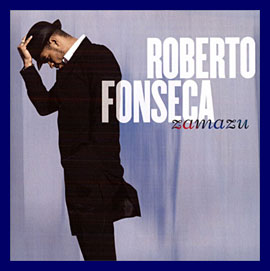12.7.7 Roberto Fonseca Cortés

Roberto Fonseca Cortés is a distinguished Cuban pianist. He was born in 1975 in Havana to a family steeped in musical tradition. Initially, he showed an interest in the drums, but at age 8, he firmly opted for the piano. At 14, he began experimenting with the fusion of traditional Cuban rhythms with American jazz, giving a concert at the 1991 Jazz Plaza Festival at just 15 years of age.
He studied at the Instituto Superior de Arte (ISA) (Calle 120 No. 1110 between 9th and 13th, Cubanacán, Playa, Havana), and earned his master’s degree in music composition. His first album, “En el principio,” was recorded with saxophonist Javier Zalba and the group Temperamento. This album won the award for Best Cuban Jazz Album in 1999. This triumph inspired him to continue working on what would become his next two albums: “Tiene que ver” and “Elengo,” which blend different rhythms such as Latin Jazz, Hip-Hop, Drum and Bass, urban music, and Cuban musical genres.
In the 2000s, Roberto Fonseca moved to Japan to record his next album, “No Limit: Afro Cuban Jazz,” with the Japanese label JVC. That same year, he began touring with the prestigious Cuban group Buena Vista Social Club, performing with excellent maestros of Cuban son such as Ibrahim Ferrer, Orlando “Cachaíto” López, Manuel Galbán, Rubén González, and Guajiro Mirabal.
Following this experience, he had the opportunity to perform in more than 400 concerts around the world, including the most prestigious venues such as the Palais des Congrès (Paris), Albert Hall (London), Beacon Theatre (New York), and Sydney Opera House (Australia). Most of the reviews of his concerts in South America and Asia referred to the young Cuban pianist’s talent and magnetism on stage.
Later, he began a special bond with fashion designer Agnés B. He also worked as a producer and arranger for Ibrahim Ferrer’s latest work, “Mi sueño: Bolero Songbook,” and served as musical director for the world tour.
After the painful loss of Ibrahim Ferrer, Roberto Fonseca knew it was necessary to begin working on his solo project: “Zamazu.” A work that unifies Afro-Cuban rhythms with classical and traditional Cuban music. This album featured award-winning Brazilian music producer Alê Siquiera, and the pianist traveled to Salvador de Bahía, Brazil, for pre-production. This work also features guest musicians Carlinhos Brown (Brazil), Orlando “Cachaíto” López (Cuba), and Cuban son diva Omara Portuondo, in addition to his regular group Javier Zalba, Omar González, and Ramsés Rodríguez.
The talented musician subsequently moved between the world tour to present his album and co-produced Ibrahim Ferrer’s album “Mi Sueño” with Nick Gold. This album was nominated for the 2007 Latin Grammy Award for Best Traditional Tropical Album.
In 2008, the song “Llegó Cachaíto” from his album “Zamazu” was included in the soundtrack of the film Hancock, starring American actor Will Smith.
His next album, “Akokan” (heart in Yoruba), was released in 2009. For this album, Roberto Fonseca collaborated with his usual musicians, including Cape Verdean artist Mayra Andrade on the track “Siete Potencias” and American guitarist Raúl Midón on “Second Chance.” This album featured him for the first time with renowned British DJ Gilles Peterson to launch the project “Gilles Peterson presents Havana Cultura new Cuban Sound.” The first album features a selection of young urban artists under the musical direction of Roberto Fonseca, performing at a variety of festivals around the world.
In 2010, the artist dedicated his career to the release of his album “Akokan” in North America, supporting Omara Portuondo, and also to the release of the remix for the Havana Cultura project: Gilles Peterson presents Havana Cultura remixed. His album “Roberto Fonseca Live in Marciac” was released in late 2010 as part of the collection promoted by the Jazz in Marciac Festival.
In early 2011, Fonseca and his group performed at the Theatre on Track in South Africa, where they were hailed as “phenomenal.”
His solo discography includes the following works: Tiene Que Ver (1999), which won an award in the Cuban popular music category at the Trimalca competition organized by UNESCO; with his group Temperamento: En el Comienzo (1999), where he won the Best Jazz Album award at the Cubadisco Festival; No Limit (2001); Elengo (2001); Zamazu (2007); Akokan (2009) and Live in Marciac (2010).
Among his collaborations in other record productions we can mention: When I Grow Up – Augusto Enriquez (1998); Black P. Marabal Bandasonora (2000); Cachaíto – Orlando Cachaíto López (2001); Happiness – Asa Festón (2002); Good Brothers – Ibrahim Ferrer (2003); Guajiro Mirabal – Guajiro Mirabal (2004); Flower of Love – Omara Portuondo (2004); Angá Echumingua – Angá Díaz (2005); Javier Zalba – Javier Zalba (2006); Timbalada – Carlinhos Brown (2006); Ibrahim Ferrer – My Dream (2007); Absolument Latino song Zamazamazu (2007); Thank You – Omara Portuondo (2008); Omara & Maria Bethânia (2008); Etxea – Kepa Junkera (2008); Gilles Peterson presents Havana Cultura New Cuban Sound (2009) and Gilles Peterson presents Havana Cultura Remixed (2010).
Roberto Fonseca, according to his biography, has been described in many ways: “the most promising and important talent in Cuban music,” “A true revelation who stands out among the pianists of his generation”… he remains faithful to his main desire since the beginning of his career: “I want my music to reach people who don’t know me, and I dream of one day turning it into a point of reference for my audience…”








